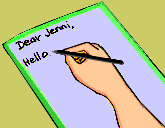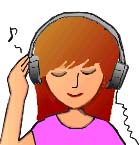| If the plain form ends with | do this | Examples | Vています (is V-ing/has V-ed) |
…く …ぐ |
…いて …いで |
かく |
|
| およぐ |
|||
| Exception: いく |
|||
…す |
…して | はなす |
|
…む …ぶ …ぬ |
…んで | よむ |
|
| よぶ |
|||
| しぬ |
|||
…る …う …つ |
…って | つくる |
|
| つかう |
|||
| もつ |
| Ex. | to study | is studying | べんきょうしています | was studying | べんきょうしていました |
| 1. | to live (すむ) | lives/is living | lived/was living | ||
| 2. | to use (つかう) | is using | was using | ||
| 3. | to have/own (もつ) | has | had | ||
| 4. | to read (よむ) | is reading | was reading | ||
| 5. | to drink (のむ) | is drinking | was drinking | ||
| 6. | to eat (たべる) | is eating | was eating | ||
| 7. | to marry (けっこんする) | is married | was married | ||
| 8. | to
come (くる) |
has come | had come |
Create sentences to describe actions in progress or repeated actions and resultant state based on the pictures below.
1. 山田 now |
2. はやし now |
3. ブラウン every day |
4. スミス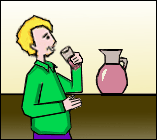 every day |
5. はやし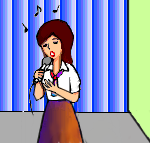 now |
6. キム now |
7. 田中 11 p.m./every day |
8. よしだ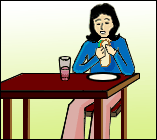 12 noon/every day |
7. すずき 3 hours/every day |
8. キム 1 hour/every week |
10. 田中 Saturday/every week |
12. スミス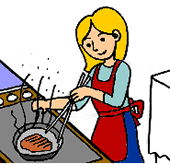 weekend/every week |
| Resultant States | |||
| 1. 山田 | 2. だれか | ||
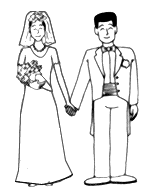 けっこんしました けっこんしました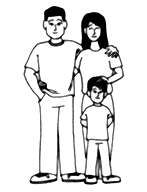 |
はいりました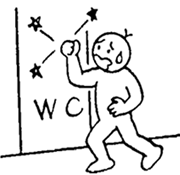 |
||
| 3. すずき | 4. 大川(おおかわ) | ||
 やせました やせました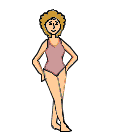 |
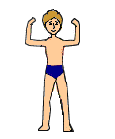 ふとりました ふとりました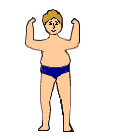 |
||
| 5. よしだ | 6. スミス | ||
 → →  おきました。いま… (is awake) |
|
||
| a. | けっこんします | I am going to get married. |
| けっこんしません | I am not going to get married. | |
| b. | けっこんしました | I got married. |
| けっこんしませんでした | I did not get married. | |
| c. | けっこんしています | I am married to someone. |
| けっこんしていません | I am not married to anybody. | |
| d. | けっこんしていました | I was married. |
| けっこんしていませんでした | I was not married. |
| 1. | Jennifer Lopez and Ben Affleck | They were
not married... They did not get married... |
|
| 2. |
Jennifer Lopez and Marc Anthony | They got married... They are married... |
|
| 3. |
Jennifer Aniston and Brad Pitt | They were married... They are not married now... |
| A |
[NAME]さんのごしゅっしんは、どちらですか? |
| B | 私は ホンコンから 来ています。 |
| A |
アトランタに どのぐらい いますか。 |
| B |
私は(13さいのとき、アトランタに 来て)10ねん (10 years) ぐらい ここに います。 |
| 1. | こどもの時、よく本をよみましたか。 | |
| 2. | ひまな時、よくなにをしますか。 | |
| 3. | 15さいの時 (at
the age of 15)、 どこにすんでいましたか。 |
|
| 4. | いそがしい時、よくなにを たべますか。 |
A. How do you address the following family members in Japanese? Fill in the blanks with appropriate terms.
| Ingroup terms
- Humble form ( (my family) |
Outgroup
terms - Honorific
form ( (your/his/her family) |
||
| 1. | parents | りょうしん (my parents) | ごりょうしん (your/his/her parents) |
| 2. | mother | おかあさん | |
| 3. | father | ちち | |
| 4. | older sister | おねえさん | |
| 5. | older brother | あに | |
| 6. | younger sister | いもうとさん | |
| 7. | younger brother | おとうと | |
| 8. | child | こ or こども | |
| 9. | grand mother | そぼ | |
| 10. | grand father | おじいさん | |
| Additional Terms | |||
| 11. | wife | おくさん | |
| 12. | husband | しゅじん | |
| 13. | daughter | むすめ | |
| 14. | son | むすこさん | |
B. Fill in the blanks using the age counters and people counter.
| age counters | people counter | |||
| ~つ | ~さい | ~人 | ||
| 1. | ひとつ | いっさい | ひとり | 一人 |
| 2. | ||||
| 3. | ||||
| 4. | ||||
| 5. | いつつ | ごさい | ごにん | 五人 |
| 6. | ||||
| 7. | ||||
| 8. | ||||
| 9. | ||||
| 10. | とお | |||
| 20. | ||||
| 1. | 何人家族(なんにんかぞく)ですか。or ご家族は何人ですか。or ご家族は何人いますか。 |
| 2. | お父さん(e.g., お母さん、お姉さん)は おいくつですか。 |
| 3. | どこに つとめていますか。 |
| 4. | ごきょうだいは 何人ですか。 |
| 5. | けっこんしていますか。 |
| 6. | どこに すんでいますか。 |
| 7. | どこで はたらいていますか。 |
| 8. | いんたいしています/じえいぎょうをしています。 |
これは、あなたの家族(かぞく)です。Family members living together are circled by in green. (Your older sister does not live with you.) Be careful with the use of family terms (Honorific terms versus humble terms).
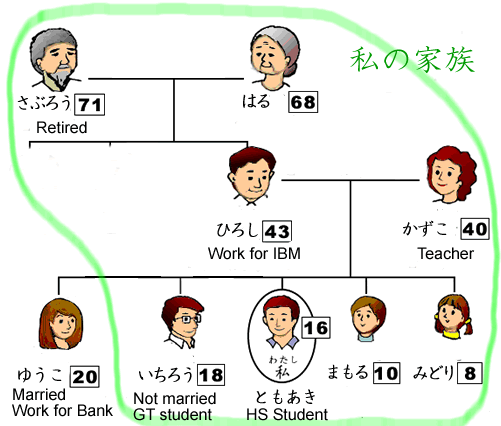
| 1. | あなたの ご家族(かぞく)は、何人(なんにん)ですか? | かぞくは九人です。 or かぞくは九人います。 |
| 2. | ごきょうだいは、何人いますか? | 四人います。 (or あにが一人と…いもうとが一人います。) |
| 3. | あなたは上から何番目(なんばんめ)ですか。 | 上から三番目です。 |
| 4. | お父さんは なんさいですか。 | |
| 5. | おばあさんは なんさいですか。 | |
| 6. | ひろしさんはこどもが何人いますか。 | |
| 7. | かずこさんのごしゅじんはだれですか。 | |
| 8. | ごきょうだいの中で、いちばん上はだれですか。 | |
| 9. | おにいさんは はたらいていますか。 | |
| 10. | おねえさんは けっこんしていますか。 | |
| 11. | おねえさんは どこに つとめていますか。 |
| 1. | ご家族(かぞく)は、何人ですか? |
| 2. | (NAME)さんは、ごりょうしんと
いっしょに すんでいますか?(live alone = ひとりで すんでいます) |
| 3. | お父さん
or お母さん は、どちらに つとめていますか (or つとめて いらっしゃいますか |
| 4. | ごきょうだいは、いますか?(an
only child = ひとりっこ) |
| 5. | Pick
one sibling mentioned above and ask: おにいさん/おねえさん/おとうとさん/いもうとさんは、学生さんですか? つとめていますか? |
Review the Vて forms (て-form review) first. Create sentences listing two separate actions using the Vて form. For example,
ごはんを たべます + おふろに はいりました → ごはんを たべて、おふろに はいりました。
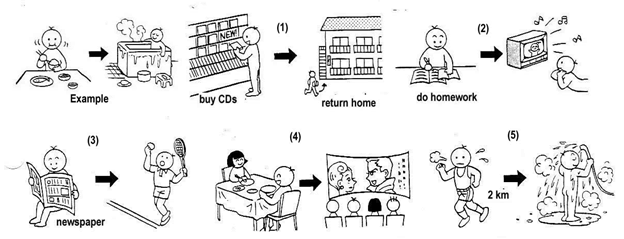
| Ex. | そのコンピュータはやすいです。 そのコンピュータはべんりです。 |
そのコンピュータは、やすくて、べんりです。 or そのコンピュータは、べんりで、やすいです。 |
| 1. | このケーキは やすいです。 このケーキは おいしいです。 |
|
| 2. | 田中さんのアパートは あたらしいです。 田中さんのアパートは きれいです。 |
|
| 3. | テックタワーは りっぱです。 テックタワーは ふるいです。 |
|
| 4. | としょかんは しずかです。 としょかんは ひろいです。 |
|
| 5. | みぎは ぎんこうです。 ひだりは デパートです。 |
|
| 6. | おとうとは 18さいです。 おとうとは せがたかいです。 |
|
| 7. | あねは 19さいです。 あねは せがひくいです。 |
|
| 8. | スタジアムは しずかじゃないです。 スタジアムは さむいです。 |
Choose two adjectives from the list below and use them to make a single sentence.
| List |
|
||||||||||||
| 1. | わたしのへやは、まどが 大きくて、つくえが あたらしいです。 ("My room has a large window and a new desk." Lit., "In my room, the window is large, and the desk is new.") |
||||||||||||
| 2. | テックのカフェテリアは、 | ||||||||||||
| 3. | わたしのコンピュータは、 | ||||||||||||
| 4. | アトランタは、 | ||||||||||||
| 5. | せんしゅうのパーティーは、 | ||||||||||||
| 6. | すうがくのクラスは、 |
 |
まる (n) or まるい (round) |
 |
ほそい (slender, skinny) |
 |
長(なが)い (long) |
 |
ほそながい (long and skinny) |
 |
しかく (n) or しかくい (rectangular) |
 |
ふとい (thick) |
 |
みじかい (short) |
せが高(たか)い (tall) せがひくい (short) of people |
| あか (n) or あかい | みどり (n) or グリーン (n) | しろ (n) or しろい | |||
| あお (n) or あおい | ちゃいろ (n) or ちゃいろい | はいいろ (n) or グレー (n) | |||
| きいろ (n) or きいろい | オレンジ (n) | くろ (n) or くろい |
- スミスさんは が きんぱつ(blonde)です。
- スミスさんと田中さんは がくろいです。(or くろです)
- 田中さんは
がみどりと くろです。
(Can't say みどりと くろいです because と connects only nouns.) - ブラウンさんは がみどりです。
- ブラウンさんは がちゃいろいです。(or ちゃいろです)
- きたむらさんは
があかで(or あかくて)、
もあかいです。(or あかです)
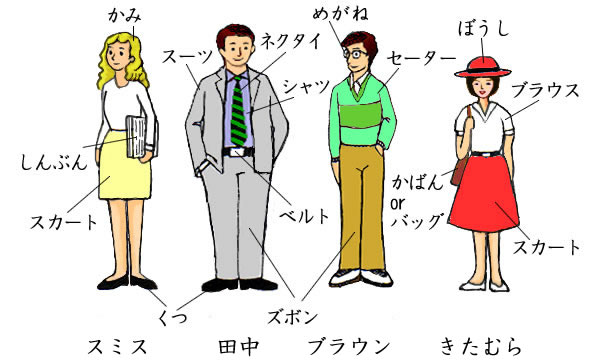
 |
1. スミスさんは しろいセーターを きています。 そして、かみが ながくて、ブロンドです。 2. 田中さんは 3. ブラウンさんは 4. きたむらさんは |

2. きいろいスカートを はいている人は です。
3. みどりのセーターを きている人は です。
4. あかいぼうしを かぶっている人は です。
5. 人は、スミスさんです。
6. 人は、田中さんです。
7. 人は、ブラウンさんです。
8. 人は きたむらさんです。
9. 人は、ブラウンさんと
きたむらさんです。
10. 人は、スミスさんと
田中さんと きたむらさんです。
Create your own question?
人は だれですか。
Some of the following clause modifiers are ungrammatical. Correct the mistakes if any.
- かみが きんぱつの人はスミスさんです。
- スカートが あかいのは きたむらさんです。
- ぼうしが あかいの人は きたむらさんです。
- ゴルフをするのが すきです。
- みどりの シャツを きているの 人は ブラウンさんです。
- ゴルフが すきな 人は 田中さんです。
- ゴルフが すきな のは 田中さんです。
- ジャケットが グレー人は スミスさんです。
- ネクタイが みどりと くろい 人は 田中さんです。
- ネクタイが くろと みどりの 人は 田中さんです。
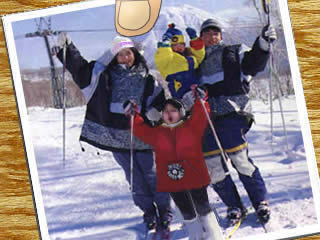 |
あなた (B) は ともだち(A)と しゃしんを みています。 A: くろいぼうしを かぶっている男の人はだれですか。 |
|
でんわを している人は田中さんです。 1. はブラウンさんです。2. は山川さんです。 3. はスミスさんです。 4. は山本さんです。 5. はすずきさんです。 |
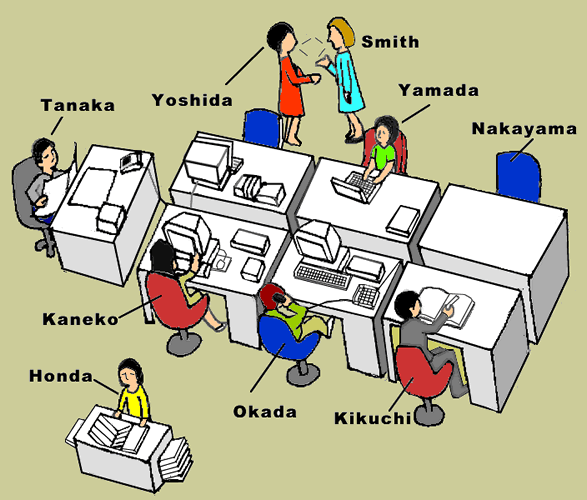 |
1. かねこさんは どの人ですか。 2. たなかさんは どの人ですか。 3. ほんださんは どの人ですか。 4. よしださんは どの人ですか。 5. おかださんは ノートを かいている 人ですか。 |
You interviewed people shown below and summarized their answers.
| しつもん | 田中 |
よしだ |
スミス |
ほんだ |
チャン |
ブラウン |
|||||||||||||||||||||
| 1. どんな スポーツが すきですか。 |
 |
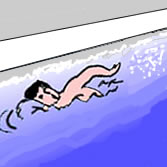 |
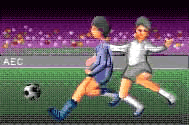 |
 |
 |
||||||||||||||||||||||
| 2. どんな プレゼントを 買いますか。 |
 |
 |
 |
 |
 |
 |
|||||||||||||||||||||
| 3. どこで ばんごはんを 食べますか。 |
 |
 |
 |
 |
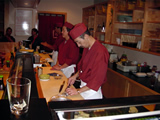 |
 |
|||||||||||||||||||||
| 4. 毎日 何時に帰りますか。 |  |
 |
 |
 |
 |
 |
|||||||||||||||||||||
| 5. ご兄弟は何人ですか。 | 1 | 3 | 0 | 1 | 2 | 0 | |||||||||||||||||||||
| 6. せんこうは何ですか。 | ビジネス | computer | けいざい学 | けいざい学 | computer | 日本ご | |||||||||||||||||||||
Give your report in the following way.
|
|||||||||||||||||||||||||||
|
|||||||||||||||||||||||||||
| 1. どんな スポーツが すきですか。 |
||||||||
2. どんな プレゼントを |
||||||||
| 3. どこで ばんごはんを 食べますか。 |
||||||||
| 4. 毎日 何時に帰りますか。 | ||||||||
| 5. ご兄弟は何人ですか | ||||||||
| 6. せんこうは何ですか。 |
- 田中さんの すきな スポーツは テニスです。
- 田中さんの 買う プレゼントは チョコレートです。
- 田中さんの ばんごはんを 食べる ところは 家です。
- 田中さんの 毎日 帰る 時間は ごご5時です。
- 田中さんの ご兄弟は 一人です。
- 田中さんの せんこうは ビジネスです。
| Body Parts, Family Terms (Kanji in boldface are newly introduced ones) |
||||
| 1. |
足 |
foot, leg | あたま | head |
| 2. | 手 | hand | かお | face |
| 3. | 目 | eye | くび | neck |
| 4. | 耳 | ear | かみ | hair |
| 5. | 口 | mouth | はな | nose |
| 6. | 母 お母さん |
my mother other's mother |
体(からだ) | body |
| 7. | 父 お父さん |
my father other's father |
せ | one's height |
| 8. | 姉 お姉さん |
my older sister other's older sister |
かない or つま おくさん |
my wife other's wife |
| 9. | 兄 お兄さん |
my older brother other's older brother |
しゅじん or おっと ごしゅじん |
my husband other's husband |
| 10. | 妹 妹さん |
my younger sister other's younger sister |
そぼ おばあさん |
my grandmother other's grandmother |
| 11. | 弟 弟さん |
my younger brother other's younger brother |
そふ おじいさん |
my grandfather other's grandfather |
| 12. | 兄弟 ご兄弟 |
my siblings other's siblings |
むすめ むすめさん |
my daughter other's daughter |
| 13. | 上から~ばん目 なんばん目 |
order from the top what order? |
むすこ むすこさん |
my son other's son |
| 14. | 家族、 ご家族 | family | ||
| 15. | 子、子ども、 お子さん | child(ren) | ||
The following is Lisa's family description. 私の家族は五人家族です。アトランタに住んでいます。父は48さいで、電話会社で仕事をしています。 |
|
| 1. | リサさんのご家族は何人家族ですか。 |
| 2. | ご兄弟がいますか。 |
| 3. | どんなご兄弟ですか。 |
| 4. | お父さんとお母さんはどんな人ですか。 |
| 5. | お父さんとお母さんははたらいていますか。どんな仕事をしていますか。 |
| 6. | リサさんは上から何ばん目ですか。 |
On T-Square's Voice Board (one of the Wimba links), record your part of the conversation (Part B) based on what you hear (Part A). Before going to the Voice Board, you can listen to Part A below. Type what you hear and prepare your lines (Part B) accordingly below and practice your lines (Part B). When ready, go to T-Square and record your answers (Part B only). The same conversation is on T-Square's Voice Board.
For 1 and 2, respond to the question by using それは~です pattern in your answer. For 3 and 4, create questions that lead to the answers given.
| 1 |
|
|
|
||||||||||||||||||||
| 2 |
|
|
|||||||||||||||||||||
| 3 |
|
||||||||||||||||||||||
| 4 |
|
 →
→ 

